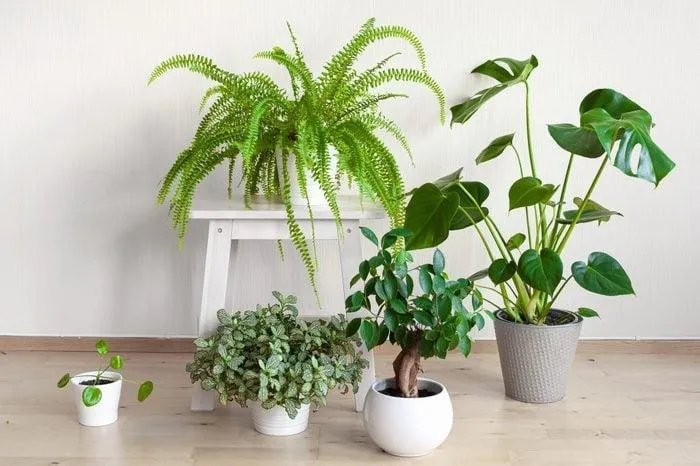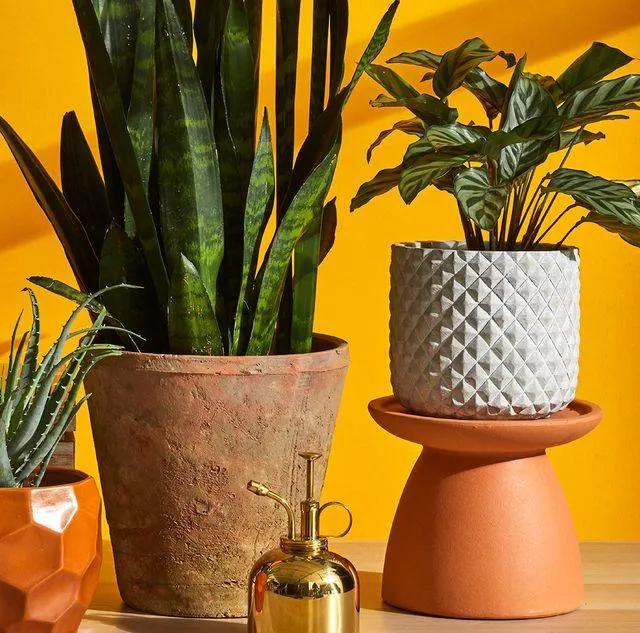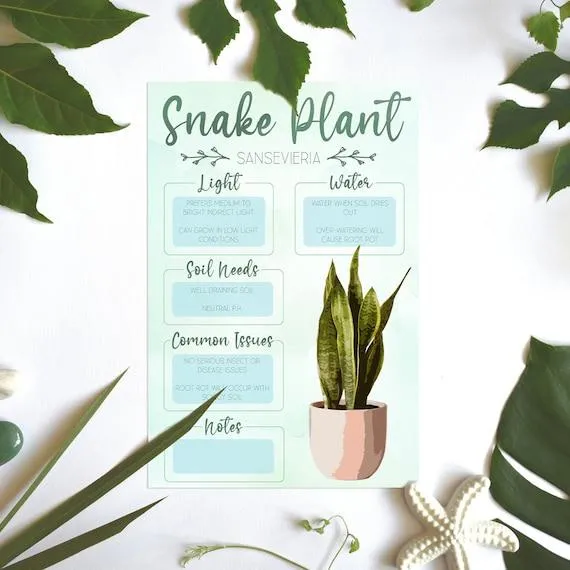Plants for Low-Light Areas: Gorgeous Greenery Without Direct Sunlight
If you have a windowless basement, shady porch, or north-facing room that doesn’t get much natural light, you may think plants are out of the question. However, there are actually many beautiful houseplants that thrive without direct sunlight. In this article, we’ll cover over a dozen top picks for low-light plants along with care tips to keep them happy indoors.
From my experience gardening in low-light spaces, pothos and snake plants are two of the hardiest options. Their ability to tolerate varying light levels has gotten them through some less-than-ideal growing conditions in my home. Both tolerate drying out between waterings too, so they’re very low-maintenance.
1. Pothos (Epipremnum aureum)
Pothos is likely the toughest houseplant out there in terms of low-light tolerance. You can put a pothos just about anywhere – even under furniture away from windows – and it’ll survive. Pothos comes in both variegated (“marble queen”) and solid green varieties. As long as you water when the top inch of soil dries out, these guys are incredibly resilient. Their trailing vines also make pothos a great choice for hanging baskets.
2. Snake Plant (Sansevieria trifasciata)
Snake plants are legendary for being virtually care-free. They’re perfectly content in low, medium, or bright light. What’s more, their upright form makes snake plants perfect for tables or as a solo specimen. Water every few weeks when dry and forget about it – snake plants are virtually indestructible. Their stripes and blades come in many varieties too, like “laurentii” with thick yellow stripes.
3. Chinese Evergreen (Aglaonema)
Chinese evergreen is among the more colorful choices for low-light. Its leaves come in shades of pink, red, green, and cream with intricate patterns. As long as it gets some indirect sunlight each day, a Chinese evergreen will bounce back from underwatering with aplomb. Just be sure not to overwater, as these plants are prone to root rot in soggy conditions.
4. Cast Iron Plant (Aspidistra elatior)
True to their name, cast iron plants can withstand periods of dryness between waterings with ease. Out of all the options here, they may tolerate the lowest light – you could keep one under a table out of direct sun. Their arching mid-century silhouette with glossy leaves comes in green and variegated forms. Their toughness has led many to consider cast iron plants nearly indestructible!

5. ZZ Plant (Zamioculcas zamiifolia)
Like pothos, ZZ plants seem programmed to survive. You really can’t kill a ZZ plant! They do fine in low to medium indirect light and prefer to dry out a bit between waterings. ZZ plants come with waxy ovate leaves in thin green and cream stripes. Their sturdy rhizomes make them tolerant of neglect too – just give them super infrequent water when dry.
6. Peace Lily (Spathiphyllum)
Peace lilies earned their name by being so easygoing they seem to spread feelings of peace! As long as they get some indirect light, a peace lily will reward you with showy white blooms. But be warned – they will wilt dramatically to signal thirst. Water whenever the soil is dry an inch down and it will perk right backup to say “thank you!”
7. Air Plane Plant (Kalanchoe)
With their thick succulent leaves and trailing stems, air plane plants handle low light well. They come in shades of pink, orange, yellow and red. Water infrequently after soil dries out and appreciate medium to bright indirect light. Their waxy leaves also allow airplane plants to endure periods of dryness better than other plants.
8. Purple Waffle Plant (Hemigraphis alternata)
If you like dramatic low-light plants, check out the purple waffle plant. Its velvety burgundy foliage looks like waffle textures. This guy tolerates very low light but will award you with more intense purple leaves if given a little indirect sun each day. Beyond that, all it needs is occasional water when soil dries out.
9. Baby Rubber Plant (Peperomia obtusifolia)
With thick succulent leaves in various shades of green and cream splotches, peperomia or baby rubber plants make interesting tabletop specimens. They handle very low light and appreciate a little sun if given the chance. Let soil dry between waterings for a plant you’ll barely have to care for! Their tightly compact form is great for small spaces too.
10. Spider Plant (Chlorophytum comosum)
Spider plants are versatile as hanging baskets or standalone plants. They tolerate low light very well with minimal care. Water whenever topsoil dries out. Their trailing strappy foliage comes in green or white/green variegated forms. Best of all, spider plants produce offsets or “spiderettes” prolifically that you can share or replant for new plants!

Now that we’ve covered 10 top low-light plant choices, let me share some additional care tips to help them thrive without direct sun:
Low-Light Plant Care Tips:
- Check soil moisture regularly by sticking your finger an inch down – water only when very dry.
- Fertilize every few months in spring/summer with a diluted liquid houseplant food.
- Rotate plants monthly a quarter turn so all sides receive indirect light evenly.
- Dust foliage occasionally and wipe leaves with a damp cloth as needed.
- Propagate by stem or leaf cuttings to expand your collection for free!
- Move plants gradually into more light over weeks if switching locations.
A few more great low-light plant options to consider:
11. Boston Fern (Nephrolepis exaltata)
With arching fronds, Boston ferns prefer medium to low indirect light. They thrive as tabletop plants and liven up darker corners! Be cautious not to overwater their soil though, as root rot could be an issue.
12. Chinese Money Plant (Pilea peperomioides)
These round leaf beauties have gotten popular due to their easy care. Water when mostly dry and move them to higher light gradually if foliage color fades. Money plants grow more compact in lower light.
13. Heartleaf Philodendron (Philodendron hederaceum)
With handsome deep green heart-shaped leaves, philodendrons do well in any low to medium indirect conditions. They’re great climbers on bookshelves or poles too. Just be sure not to overwater the soil.
Plants without direct sun may grow more slowly, but with some patience and the right choices, you can still create a lush indoor jungle in shadier spots! Looking for something unusual? Try maranta, calathea or aglaonema varieties – just go slowly acclimating them to avoid crispy leaves.

I hope this guide has shed some light (pun intended!) on amazing options to bring greenery into your low-light rooms. Experiment to see which thrive best in your particular conditions. Growing houseplants can be very rewarding – from my experience, it’s relaxing to nurture living things and brightens any space. Please let me know if you have any other questions!
Plants That Don’t Require Sunlight
| Plant | Light Requirement | Care Tips |
|---|---|---|
| Chinese Evergreen | Low Light | Water when top inch of soil is dry. Fertilize in spring. |
| Pothos | Low Light | Let soil dry between waterings. Prune as needed. |
| Peace Lily | Low Light | Water when soil is dry. Flowers signal need for water. |
| Spider Plant | Low Light | Water weekly. Propagate by dividing baby plantlets. |
| Philodendron | Low Light | Water when top inch of soil is dry. Prone to spider mites. |
FAQ
-
What plants can grow without sunlight?
Some plants that don’t need a lot of sunlight include spider plants, philodendrons, peace lilies, Chinese evergreen, pothos, and zz plants. They can basically survive in low-light spots.
-
Do mushrooms need sunlight?
Most mushrooms don’t need sunlight. In fact, mushrooms usually grow in shady, moist areas under trees or in caves. They get their energy from breaking down organic material in the soil using a process called decomposition. So mushrooms kind of survive in the dark by eating stuff that has died!
-
Can succulents live without sunlight?
While succulents love sunlight, some varieties may still survive without a lot of light. Snake plants and jade plants appear to tolerate low light better than other succulents. But they won’t grow very fast or look their best without some sun exposure. So you gotta give succulents at least a few hours of sunlight every week to stay healthy.
-
Can ferns grow in the shade?
Many ferns can grow nicely in shady spots. Tree ferns, polystichum ferns, and wood ferns are great choices for shade gardens. However, some ferns like bird’s nest and cinnamon ferns prefer part-shade. I guess different ferns have varying needs for sunlight. So when picking a fern, consider how much shade the spot gets. You wouldn’t want to put a full sun fern in a super dark area!
-
Do air plants need sunlight?
Despite their name, most air plants still require some sunshine. While they don’t need soil, air plants utilize sunlight as an important source of energy through photosynthesis. Providing at least six hours of direct or indirect bright light daily ensures air plants stay healthy and colorful. In low-light situations, air plants may lose their rich hues and eventually perish. So bright sunshine seems essential for these quirky plants!

-
What’s the least amount of sunlight needed for plants?
Experts say most houseplants need at least four to six hours of indirect sunlight every day. Indirect sunlight means light that filters through a window rather than direct rays. Strong morning or afternoon light works best. If the plant spot only gets two hours of very low light, you might try growing something like pothos or philodendron. But beware, even these low-light plants may start looking sad and leggy without sufficient illumination. I guess more sun is usually better for plant health, but some varieties tolerate the gloom.
